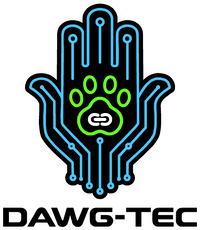Balanced Dog Training: The Proven Method for Real-World Results
- by Tyler Toomey
🐾 Balanced Dog Training: The Proven Method for Real-World Results
By Dawg-Tec | June 2025
When it comes to dog training, there’s no shortage of opinions. Some swear by positive reinforcement-only methods, while others focus on structure and discipline. But after decades of real-world experience and results, one method has proven consistently effective for building calm, confident, and obedient dogs:
👉 Balanced dog training.
So where did this approach come from? Why is it often misunderstood or debated — and why do thousands of owners and professional trainers stand by it as the most effective path forward?
Let’s explore the history of dog training and discover why balanced training is the approach that truly works — not just in theory, but in the real world.
📜 A Brief History of Dog Training Methodologies
🪖 1. The Traditional Era (Pre-1980s)
Before modern behavioral science took hold, dog training was largely correction-based. Trainers used slip leads, leash pressure, and firm commands to gain control and compliance. A leading voice during this period was William Koehler, a military dog trainer who authored The Koehler Method of Dog Training — a system that prioritized structure, timing, and consistency.
While these traditional techniques worked for working dogs like police and military K9s, they were sometimes viewed as overly rigid or harsh by later generations of trainers.
🍖 2. The Positive Reinforcement Revolution (1980s–2000s)
The next major shift came from the world of marine mammal training and behavioral science. Trainers like Karen Pryor, author of Don’t Shoot the Dog!, popularized positive reinforcement training and clicker training, based on operant conditioning.
The focus was on rewarding desired behaviors while ignoring unwanted ones — eliminating corrections or aversive techniques altogether. This force-free approach gained massive popularity, especially among pet owners.
However, many trainers and dog owners began to notice a serious gap:
Purely positive methods often fell short when faced with real behavioral problems like reactivity, aggression, and serious disobedience.
⚖️ 3. The Rise of Balanced Dog Training (2000s–Present)
As the limitations of positive-only training became clear, a new generation of trainers began combining the best of both worlds. This blend of motivation and consequence, grounded in both science and experience, gave rise to what we now call balanced dog training.
Balanced training uses:
- Positive reinforcement to build desired behaviors
- Fair, clear corrections to stop dangerous or inappropriate ones
- Structure and consistency to help dogs understand boundaries
This approach isn’t “new” — it’s the natural evolution of dog training as both science and practicality advanced.
💡 What Is Balanced Dog Training?
Balanced dog training uses all four quadrants of operant conditioning, but focuses primarily on two:
- Positive reinforcement (R+) — to teach and strengthen desired behaviors
- Positive punishment (P+) — fair corrections to interrupt or stop unwanted behaviors
It’s not about being harsh. It’s about giving dogs clear, consistent communication. Balanced trainers use tools like treats, toys, praise, leash pressure, prong collars, or remote e-collars — not to punish, but to guide the dog toward calm, safe, obedient behavior in any environment.
The goal? A dog that doesn’t just behave when a treat is in your hand — but one that’s reliable, respectful, and calm even under pressure.
🚨 Why Purely Positive Training Often Falls Short
The idea of “never saying no” to your dog may sound compassionate — but in practice, it often leads to confusion, chaos, and, sadly, surrendered dogs.
Here’s the truth:
You can’t reward your way out of aggression or reactivity
Ignoring bad behavior doesn’t make it go away
Real-world obedience requires more than cookies and hope
Every year, thousands of dogs are rehomed or euthanized not because they’re bad — but because they were never given proper structure and accountability. Balanced dog training doesn’t just teach manners. In many cases, it literally saves dogs’ lives.
🧠 Blending Science With Real-World Results
Balanced trainers use modern behavioral science, not myths. But they also recognize that the world isn’t a controlled classroom. It’s full of distractions, triggers, and risks — and your dog needs to learn how to behave in those unpredictable environments.
Whether it’s leash pulling, resource guarding, or refusing to recall — dogs thrive when there’s clarity, structure, and consequences.
🌟 Influential Balanced Trainers You Should Know
The balanced training community includes respected professionals who’ve helped rehabilitate thousands of dogs and change lives for owners across the globe. Notable names include:
- Jeff Gellman – Solid K9 Training
- Sean O’Shea – The Good Dog
- Larry Krohn – Pak Masters
- Tom Davis – Upstate Canine Academy
- Tyler Muto – K9 Connection
- Duke Ferguson – Pro Dog Trainer
- Michael Ellis – Renowned educator and working dog trainer
These trainers have one thing in common: real-world results where other methods failed.
🐕🦺 The Dawg-Tec Philosophy
At Dawg-Tec, we believe in balanced, humane, and effective training tools that support communication — not confusion.
That’s why our patented E-Harness system is designed to work with real-world training techniques. Whether you’re using voice commands, remote collars, or structured leash work, our system helps dog owners train smarter, not harder.
We’re not here to follow trends or push ideology. We’re here to empower dog owners with tools that work — and save dogs that others give up on.
📣 Ready to Train Smarter?
Join the growing community of dog owners and trainers who are choosing balanced training — because your dog deserves more than good intentions. They deserve real results.
👉 Visit us at www.dawgtec.com
📱 Follow us on Instagram: @dawgtec



